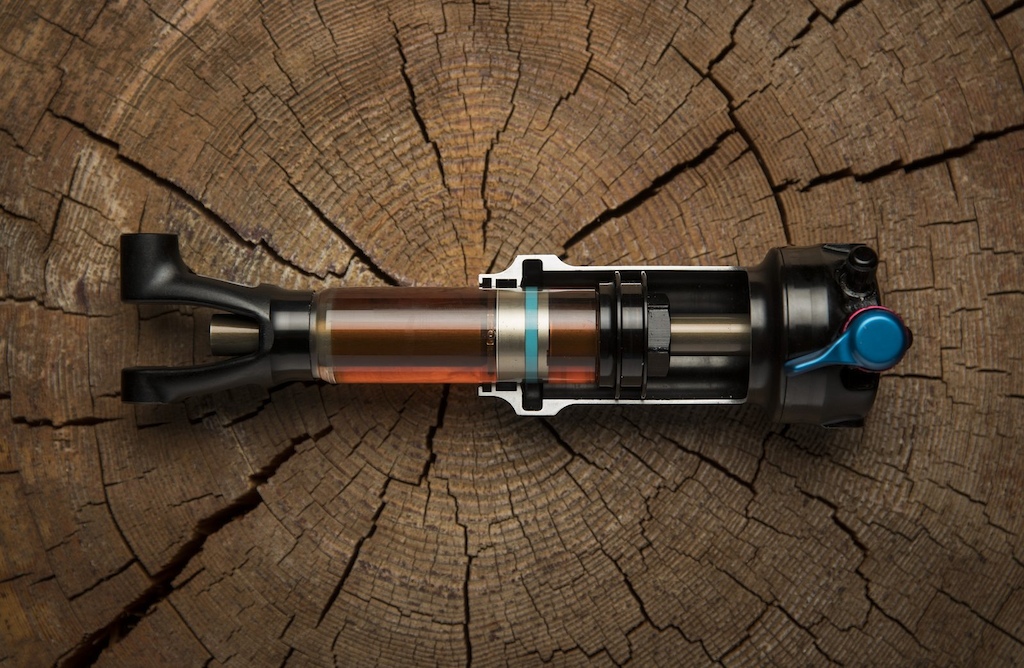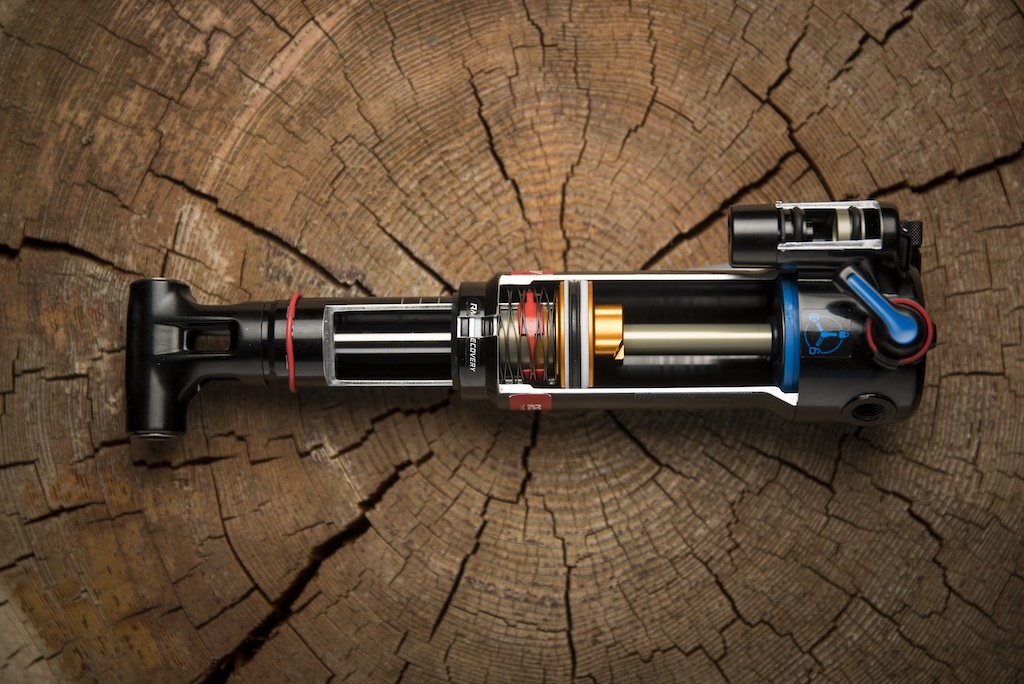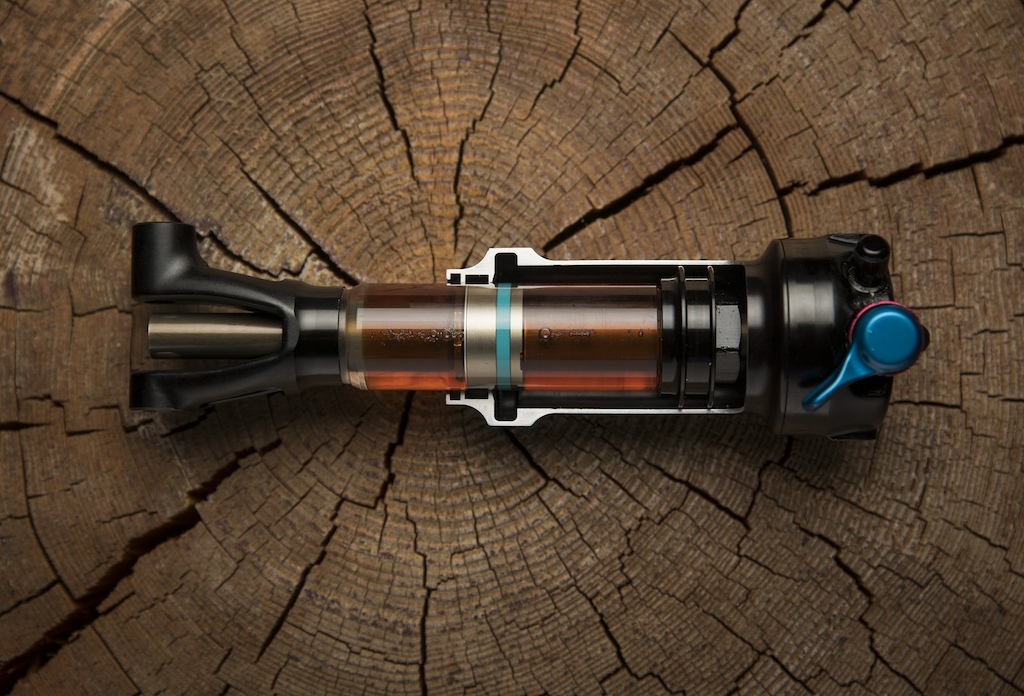Trek Debuts New RE:aktiv Thru Shaft Shock Technology
Trek released their original RE:aktiv suspension units early summer 2014. Working in conjunction with Penske Racing shocks, a high-end suspension manufacturer focused on the racing worlds of Indy and NASCAR, they initially brought the technology to the market using Fox as their supplier of this exclusive technology. For 2018/19 Trek has exclusive use of a new technology compressed down from motor racing and into mountain bike suspension. RE:aktiv adds the 'Thru Shaft' label, which is a replacement for longstanding internal floating pistons found on nearly all shocks.
Trek admits that this technology isn't brand new; AMP, White Brothers, Manitou, and RockShox all experimented with this technology back in the 1990's, but manufacturing techniques at the time meant that a reliable product was tough to create. Fast forwards twenty years and things have moved on, and Trek now believes they have a durable product with improved performance. Why does the performance improve? An IFP creates some friction and lag in all shocks; even as seals and coating have improved, there is always a static force to overcome. The Thru Shaft works around this issue by allowing oil to be displaced freely and eliminates the IFP and nitrogen/air charges.
More proprietary technology? Fox and RockShox will be supplying Trek exclusively with shocks for the next two years, but the technology is open source, so we may see this appear on other brands in the future. Penske still retains the patent on the regressive RE:aktiv valve, so this will continue to be unique to Trek for the foreseeable future.
Trek Explains Thru Shaft:
How does RE:aktiv with Thru Shaft compare to other all-mountain or enduro shocks like the Fox X2 or RockShox Super Deluxe?
RE:aktiv with Thru Shaft is the only damper that eliminates oil displacement, the dynamic internal floating piston (IFP), and gas charge; as a result of this elimination, RE:aktiv with Thru Shaft has reduced hysteresis (lag) and more balanced damper pressures, which allows it to more quickly and effectively react to changing terrain. Overall, it’s a much more responsive damper with the same air spring performance.
What does all of that mean? How does eliminating oil displacement benefit the rider?
In a traditional air shock, the damper shaft displaces oil as the shock moves through its stroke. The IFP, a gas-charged piston in the damper, compensates for this constant change in damper volume. As the damper rod displaces oil, the increased damper volume creates enough pressure to compress the gas charge and move the IFP. As the shock rebounds and pressure is reduced, the IFP will start floating back to its original position, and the cycle continues. The rod pressure from the gas charge and the stick and slip effect of the IFP’s movement create hysteresis, or lag, which keeps the shock from working as quickly as possible. By eliminating oil displacement, we also eliminate the need for a dynamic IFP. With no dynamic IFP, hysteresis is dramatically reduced, which creates a damper that reacts to changing terrain significantly faster than anything else available.
How does RE:aktiv with Thru Shaft eliminate oil displacement?
Rather than a single damper shaft that displaces oil as it moves deeper into the stroke, Thru Shaft uses a shaft on either side of the damper valve that moves through a single, solid column of oil. As the main shaft enters the damper, the secondary shaft exits the damper on the other side. Conversely, as the main shaft exits the damper, the secondary shaft enters the damper on the other side. This results in a constant damper volume with no displacement and more balanced internal pressure.
How does all this affect the rider?
It’s a more responsive shock. With no IFP force acting against the damper shaft, small-bump sensitivity is greatly improved. Eliminating the dynamic IFP also eliminates its friction and stick and slip effect, so not only is the shock movement easier to initiate, it also changes direction much faster. The solid column of oil and immediate pressure balance result in more support and efficiency with faster response to terrain throughout the stroke. In total, this shock amplifies the responsiveness of a standard RE:aktiv shock, and keeps your rear tire glued to the trail so you can ride with even more confidence.
With no dynamic IFP, how does the shock manage heat-induced fluid expansion?
The longer-stroke RockShox version uses an external reservoir for thermal compensation. Since the shorter-stroke Fox version has less total oil volume, Fox was able to include a thermal compensator within the main damper shaft. Due to the use of a flow control check valve, thermal compensation on RE:aktiv with Thru Shaft takes place during moments when the shock is static. This eliminates the need for a dynamic IFP function and an associated IFP gas charge, which is necessary for traditional dynamic IFP shock function.
Do the added seals cause extra stiction?
Eliminating the dynamic IFP’s stick and slip effect and the IFP’s gas charge nose force on the main damper shaft greatly outweighs any potential added stiction from the additional Thru Shaft secondary shaft seals.
For 2018, Thru Shaft is limited to higher end Trek models including the Slash 9.8 / 9.7, Remedy 9.8 and Fuel EX 9.9. It will also be supplied on Slash, Remedy, and Fuel EX carbon framesets. Expect to see the tech trickle down to cheaper models in the future, but buying aftermarket shocks to upgrade your old bike will not be an option yet.
Trek admits that this technology isn't brand new; AMP, White Brothers, Manitou, and RockShox all experimented with this technology back in the 1990's, but manufacturing techniques at the time meant that a reliable product was tough to create. Fast forwards twenty years and things have moved on, and Trek now believes they have a durable product with improved performance. Why does the performance improve? An IFP creates some friction and lag in all shocks; even as seals and coating have improved, there is always a static force to overcome. The Thru Shaft works around this issue by allowing oil to be displaced freely and eliminates the IFP and nitrogen/air charges.
More proprietary technology? Fox and RockShox will be supplying Trek exclusively with shocks for the next two years, but the technology is open source, so we may see this appear on other brands in the future. Penske still retains the patent on the regressive RE:aktiv valve, so this will continue to be unique to Trek for the foreseeable future.
Trek Explains Thru Shaft:
How does RE:aktiv with Thru Shaft compare to other all-mountain or enduro shocks like the Fox X2 or RockShox Super Deluxe?
RE:aktiv with Thru Shaft is the only damper that eliminates oil displacement, the dynamic internal floating piston (IFP), and gas charge; as a result of this elimination, RE:aktiv with Thru Shaft has reduced hysteresis (lag) and more balanced damper pressures, which allows it to more quickly and effectively react to changing terrain. Overall, it’s a much more responsive damper with the same air spring performance.
What does all of that mean? How does eliminating oil displacement benefit the rider?
In a traditional air shock, the damper shaft displaces oil as the shock moves through its stroke. The IFP, a gas-charged piston in the damper, compensates for this constant change in damper volume. As the damper rod displaces oil, the increased damper volume creates enough pressure to compress the gas charge and move the IFP. As the shock rebounds and pressure is reduced, the IFP will start floating back to its original position, and the cycle continues. The rod pressure from the gas charge and the stick and slip effect of the IFP’s movement create hysteresis, or lag, which keeps the shock from working as quickly as possible. By eliminating oil displacement, we also eliminate the need for a dynamic IFP. With no dynamic IFP, hysteresis is dramatically reduced, which creates a damper that reacts to changing terrain significantly faster than anything else available.
How does RE:aktiv with Thru Shaft eliminate oil displacement?
Rather than a single damper shaft that displaces oil as it moves deeper into the stroke, Thru Shaft uses a shaft on either side of the damper valve that moves through a single, solid column of oil. As the main shaft enters the damper, the secondary shaft exits the damper on the other side. Conversely, as the main shaft exits the damper, the secondary shaft enters the damper on the other side. This results in a constant damper volume with no displacement and more balanced internal pressure.
How does all this affect the rider?
It’s a more responsive shock. With no IFP force acting against the damper shaft, small-bump sensitivity is greatly improved. Eliminating the dynamic IFP also eliminates its friction and stick and slip effect, so not only is the shock movement easier to initiate, it also changes direction much faster. The solid column of oil and immediate pressure balance result in more support and efficiency with faster response to terrain throughout the stroke. In total, this shock amplifies the responsiveness of a standard RE:aktiv shock, and keeps your rear tire glued to the trail so you can ride with even more confidence.
With no dynamic IFP, how does the shock manage heat-induced fluid expansion?
The longer-stroke RockShox version uses an external reservoir for thermal compensation. Since the shorter-stroke Fox version has less total oil volume, Fox was able to include a thermal compensator within the main damper shaft. Due to the use of a flow control check valve, thermal compensation on RE:aktiv with Thru Shaft takes place during moments when the shock is static. This eliminates the need for a dynamic IFP function and an associated IFP gas charge, which is necessary for traditional dynamic IFP shock function.
Do the added seals cause extra stiction?
Eliminating the dynamic IFP’s stick and slip effect and the IFP’s gas charge nose force on the main damper shaft greatly outweighs any potential added stiction from the additional Thru Shaft secondary shaft seals.
For 2018, Thru Shaft is limited to higher end Trek models including the Slash 9.8 / 9.7, Remedy 9.8 and Fuel EX 9.9. It will also be supplied on Slash, Remedy, and Fuel EX carbon framesets. Expect to see the tech trickle down to cheaper models in the future, but buying aftermarket shocks to upgrade your old bike will not be an option yet.
Author Info:
Must Read This Week
How to Watch the 2024 Mountain Bike World Cup [Update: Staylive Offering Access in New Zealand, South Africa & More]
60434 views
60434 views
[UPDATED] Final Elite XC Results & Overall Standings from the Mairiporã XC World Cup 2024
41350 views
41350 views
Sign Up for the Pinkbike Newsletter - All the Biggest, Most Interesting Stories in your Inbox
PB Newsletter Signup






www.goodreads.com/quotes/6436-there-s-an-old-saying-in-tennessee-i-know-it-s
They should be recalled just so shops dont have to tell people theres no parts to fix them.
www.evilmilk.com/pictures/Social_Justice_Warriors_5.jpg
At least it doesn't have an inane autosag valve on it.
Coincidentally, I watched it just last night.
More importantly though, hysteresis is a buzzword (like cavitation) that is thrown around a lot because it sounds uber techy, but is also very commonly misunderstood. A lot of shocks market themselves as "low hysteresis" which is absolutely relevant if it's for an F1 car that needs huge forces very suddenly at low velocities, but not so important on long travel suspension on mountain bikes.
That article speculates it is due to hysteresis.
Also of note is that they do seem to still use a pressurized chamber of some sort to prevent cavitation & provide space for thermal expansion... I'm guessing the thermal compensator they talk about is doing both duties here as well. It seems that through shafts generate a much smaller pressure delta across the piston, so the amount of pressure needed to prevent cavitation is probably much less than a typical shock.
If you're really worried about hysteresis, better dump your clutch derailleur. That makes x10 the difference as losing a seal in an IFP
I talk about it purely because I'm interested in suspension design, & what goes into making a shock that doesn't have these problems.
End of the day, I'm a weekend warrior, but I still want my Cane Creek Helm and CCBD Coil CS to synergise together for 'the perfect ride'
The problem is, I'll never know exactly where 'the perfect ride' is. Bike feels damn good though
I mean, I'm in Australia, you're no use too me..... but I would totally pay a 'guru' to come and ride with me to help me get the best out of my suspension.
@Waldon83 only in the Whistler Bike Park right now sorry!
@tehllama bladders definitely cut out one of the sources of friction, and in an air shock where the negative spring can be designed to negate the gas charge preload very closely, they do pretty much cover all bases. They aren't perfect though - assembly of shocks using bladders is less precise than IFPs and there is more room for error. For coil shocks, the through-shaft system makes sense from a theoretical standpoint (packaging is a bit of a pain though), unless you want to use something like Countermeasure to negate the gas charge, but then that system has its own associated issues (noise/knocking among other things).
1. Trek ask Penske to design a shock valving based on their track experience.
2. Trek does a lot of marketing communication on their new shock tech
3. But some yeas later they realized that implemented regressive valving in MTb shock made become hysteresis an issue
5. So Trek ask Penske to design a new solution to deal with increased hysteresis
6. Trek made a lot of communication into solving an issue (hysteresis) that is not relevant with standard shock and present that as a huge improvement...
Looking in details at the rockshox implementation, it seems that the upper shaft (above pistion and contermeasure) is thinner in diameter than the lower shaft. I wonder if the small piggyback is not for compensate a small volume change due to shaft diameter differences.
as an Suspension Designer i would add following to your information: on IFPs the pressure differential between the oil and gas side ( besides the initial pressure created by the stction force of the nominal sealing force) is nearly zero - therefore the friction force of the sealing is quite low. Especially compared to a shaft sealing on a thru shaft damper, that always has to seal the oil pressure against atmospheric pressure. Sealings create a friction force highly dependend on the pressure they have to oppose.
They didn't, but there wasn't a lot on the shocks as they were long-stroke / low leverage designs. The Amp Mac-strut bikes (B2 thru B4) had nearly 2 inches of shock shaft travel for only a 3" wheel travel. In comparison, a GT RTS of the same era had the same wheel travel but got it from moving a shock shaft only one inch. They also spec'ed automotive grade oils as their background was in motorsports. One of the acceptable fluids was ATF fluid, which in terms of shock oil works out as about an 8 weight fluid. Its also designed for high heat applications.
as for dirt ingress, from a sealing perspective, this is essentially just the shaft from a coil shock. If we can keep the oil clean on those, this shouldn't pose any extra challenges.
From my understanding, the ifp move to compensate fluid volume reduction due to main piston shaft displacement. So I was thinking that even if they are not mecanicaly linked, since fluids are incompressible, as soon as the main piston move, the ifp should move too, even if their respective displacement length is not the same due to different diameters (but same volume displacement). So can you please explain how the ifp is floating independently of the air shaft ? This is a genuine question, I'm not ironical.
But how much friction does the dust lip have compared to the pressure seal
@bigtim imagine you have a bottle of water that's full right to the top with water. You stick your finger in the bottle of water, the volume of your finger occupies space that water used to occupy, pushing water out the top of the bottle. That water has to go somewhere obviously, so in this case it just overflows and leaves the bottle. We don't want that to happen with our shocks, so we seal them up to stop the oil getting out, but that means we still need some method of compensating for the volume of the shaft as it enters the sealed chamber. You can either introduce an IFP with an elastic medium behind it (pressurised gas or a spring or whatever) that can move out of the way, or you can cut a hole in the other end, and have as much volume leaving the shock as you have entering it.
Oh well I thought it was the other way round. Thank you
= ̄ω ̄=
Many tanks use the oleo damper and it's oil dampend. It's also used in planes
Thank you for that !
Nirto update
Yes, oil circulates in a twin tube design. But the internal volume of oil is being displaced by the same amount.
Edit: The shafts are probably smaller because they don't have to house a channel for the rebound damper.
Yep. That's true.
On traditional designs, they make the shaft thicker intentionally, so more oil is displaced, making it easier to control the compression. I'm not completely knocking the traditional design, the elvensix by push uses it, but its just executed to perfection, something you're not getting on a fox float or monarch.
Why the hell are people downvoting @shredteds? He is exactly right.
不要天天就想着搞个大新闻
Great if it produces better shocks but many current bike designs could not use this I suspect.
Now here comes Sram and Fox again licking Trek's a$$ and making exclusive shock sizes to Trek.
Can anybody understand this?!
shop.penskeshocks.com/PENSKE-RACING-SHOCKS-7700-THRU-ROD-SHORT-TRACK-SHOCK
shop.penskeshocks.com/files/downloads/PS_7707_TR_088C%20(REV%201).pdfREV%201
It appears that not all of the shock "stanchion" (is it called a stanchion on a shock?) will be used at full compression. Based on that last picture stroke length will be fairly different than overall stanchion length. Interesting.
I am in no way biased but Cannondale were well ahead of the game in terms of suspension design over the major brands.
The simple fact is that we are being fed all of this nonsense when all we really need is a coil shock that weighs nothing with different models offering varied damping performance (basic(lsc+lsr) and pro(hsc/lsc + hsr/lsr) for instance).
No more multi shafts with moondust charred bladders and unicorn horn air cans that require more maintenance than Trumps wig.
........Closest there is at the minute is a Fox x2 coil w/lever.
They replace one seal with another and the world becomes a better place?
PD: sorry for Google translator
I'm guessing Fox could have floating piston inside the shaft and rubber pellet at the end.
R3act - Marin, Polygon
www.youtube.com/watch?v=AciQwmN0Sk8